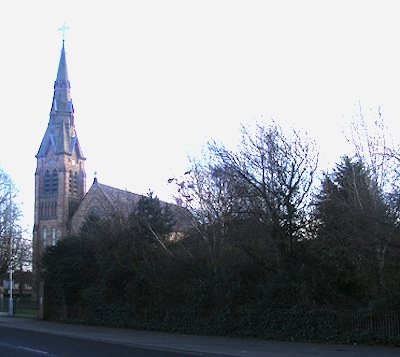
A new wall is to be built along a sectarian interface in east Belfast through the grounds of St Matthew’s Catholic church, as talks are set to resume on issues such as flags and parades.
The fence is to be constructed along the interface between the nationalist Short Strand and the loyalist Newtownards Road. Several other “peace walls”, some as high as 25 feet, already exist in the area, but the church grounds have always been relatively unprotected.
St Matthews’s was the site of a famous and defining battle in 1970, said by many to have marked the emergence of the Provisional IRA as it moved to protect the church from attack. The nationalist Short Strand and the church itself has been targeted several times over the past year as loyalist mobs have again turned their anger against the enclave over issues such as flag-flying and parades.
Parish worker Willie Ward from St Matthew’s said the new fence would help to prevent stone-throwing and loyalist raids.
“Definitely, the people who live in Strand Walk and St Matthew’s Court on our side have asked for it,” he said. “The only place for it to go is in the church grounds. I think it will go a long way towards helping solve the problem.”
Lands are to be purchased from St Matthew’s by the Six-County Department of Justice for the construction of the fence.
Justice Minister David Ford said the wire-mesh, retractible fence was “innovative” in that it could be raised or lowered as circumstances require. He insisted that reducing the number of interface walls and barriers “remains a priority”.
But tensions have rarely been higher along many interfaces in Belfast following several riots by loyalist paramilitaries over the summer marching season.
MURAL DEFACED
In north Belfast, a ‘protest encampment’ continues to be maintained by loyalists and the Orange Order at the sectarian interface with the nationalist Ardoyne community. A mural erected by that community to honour prominent local republican Martin Meehan was attacked by loyalists this week within days of its unveiling.
The image on Ardoyne Avenue shows a picture of Meehan, who later went on to serve as a Sinn Fein councillor, wearing an IRA uniform and carrying a rifle. The image is based on a picture taken in the early 1970s, and was unveiled on Sunday on the anniversary of the former IRA man’s death in 2007.
His son, Martin Og Meehan said a “hysterical” response to the image of his father by some unionist politicians had motivated the attempt to destroy it.
“What was a family act of remembrance has been turned into a political football by unionists who are using it to distract from their own internal difficulties”, he said.
“The vandalism of the mural was I believe loyalist reaction to that hysteria.
“We have had great support from the people of this area who held my father in high esteem and intend to clean the mural up and so it will stay where it is,” he added.
In recent weeks there has been a controversy over the appearance of several unionist paramilitary (UVF) murals on walls in east Belfast, including one just steps away from a PSNI police base, all of which feature armed and masked paramilitaries.
SYMBOLIC
And an ongoing dispute over the flying of the British flag deepened this week with news that five unionist-controlled government buildings in Belfast are to begin flying the Union Jack, while Belfast City Hall was bathed in red and white light last week to mark the British Army’s Poppy Appeal.
The issue of flags and symbols is one which US mediator Richard Haass is seeking to address as part of an ongoing talks process.
The all-party talks on flags, parades and the past will likely conclude at the end of the year with a round of intensive negotiations. Mr Haass indicated this week that ‘hothouse’ discussions similar to those that led to the signing of the Good Friday Agreement and the 2010 Hillsborough accord, may take place around Christmas.
But expectations for the talks remain low after bitter exchanges erupted this week following an emotive documentary on the ‘Disappeared’, the small group of IRA victims whose bodies were clandestinely buried.
Following the joint RTE/BBC broadcast, Sinn Fein leader Gerry Adams was strongly criticised over his continued denial of past IRA membership, as well as his denial of allegations that he was involved in the disappearance of Jean McConville, a mother of six who was executed in 1972 as an informer.
The talks were also given a greater imperative in recent weeks by a continuing series of bomb alerts, hoaxes and false alarms. But as in recent months, none of the incidents resulted in an explosion or injury.
On Wednesday morning, a large area of Derry around the Buncrana Road was sealed off, but the incident was later declared to have been a false alarm. A former member of the RUC police said that he found an object underneath his car on Friday A Crown force spokesperson later said the item found in east Belfast had been a viable device.
Amid the ongoing rancour, Haass said the focus of the talks process would now involve a greater focus on face-to-face talks between the main political parties in the Six Counties. While it is thought unlikely he will hold public talks with representatives of any of the armed groups, he suggested that the talks could become more all-embracing.
“We will increasingly be trying to uncover and expand areas of agreement in the three areas that we are looking at,” he said.
![[Irish Republican News]](https://republican-news.org/graphics/title_gifs/rn.gif)
![[Irish Republican News]](https://republican-news.org/graphics/title_gifs/harp.gif)

